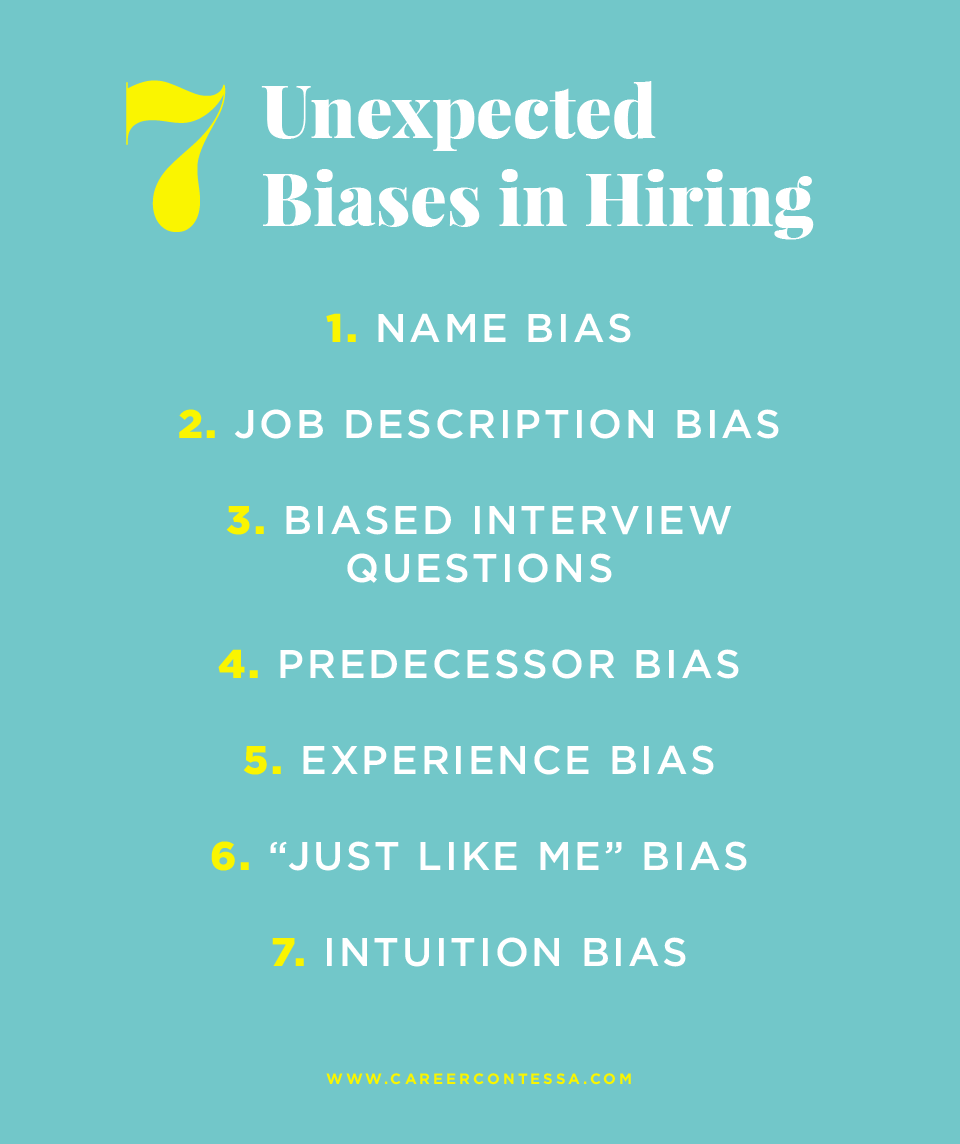We all know bias exists, but do we think about how it exists within the workplace? Do we think about how our workplace decisions might be influenced by our own personal bias?
Just like anywhere else it pops up, bias in the workplace is a destructive force that influences decisions, workplace hierarchy, and
leadership structures.
Here are some common biases that exist in the workplace. Some seem innocent on the surface but are actually insidious in nature.
Name Bias
We’re starting with this one because it’s a common bias. It’s so common, in fact, that there are countless studies about “whitening” names on resumes to appear as a more ”desirable” candidate.
A study by Katherine DeCelles and Sonia Kang called
Whitened Resumes: Race and Self-Presentation in the Labor Market created two sets of resumes for 1,600 jobs posted on job sites in 16 metropolitan cities. Some resumes included information that clearly pointed out applicants' minority status—including their names—while others were “whitened” or scrubbed of any racial clues.
When Black candidates’ resumes were “whitened”, they received callbacks at a rate of 25 percent. The same Black candidates without whitened resumes only received a callback rate of 10 percent.
Another study by
Ryerson University and the University of Toronto sent out 13,000 resumes to over 3,000 job postings. Of these 13,000 resumes submitted, those with Chinese, Indian, or Pakistani-sounding names received 28 percent fewer callbacks than the same resumes with fictitious names.
The name bias is real. Use your favorite search engine to browse through dozens of studies on how changing the name on your resume can have huge impacts on whether or not you’re even considered for an interview.
Predecessor Bias
Predecessor bias happens when a hiring manager takes pause or reconsiders a hire not on the candidate’s merit, but on the experience with the person who held the job before.
For example, say Company XYZ hired a brunette woman for a role and, for whatever reasons, had a bad experience with the hire. When a brunette woman comes in to interview, the hiring manager sees not a new candidate, but the potential to repeat the same experience over again. This person, through no fault of their own, is immediately disqualified.
Do not judge a person by someone else’s wrongdoings or perceived sins against you. Every person deserves the opportunity to work as and for themselves without being slipped into a puddle of bias that has nothing to do with them or their work.
Experience Bias
Of course, many jobs are going to require a certain type of experience. Someone who has never written a line of code is not going to show up for a Senior Engineer position. However, there are times where bias can show up when weeding for “experience.”
Experience bias can mean discounting someone for having attended (or not attended) a certain school, lacking formal education or a certain degree, or having worked at a specific type of company.
Hiring for experience or skill means just that. It is becoming increasingly common for companies to hire
without requiring a college degree. This is partly because many jobs require hands-on experience that either isn’t taught at schools or that can be self-taught. If you’re in a position to hire and you’re scanning the resume for an Ivy League name, ask yourself why.
“Just Like Me” Bias
This happens when a manager wants to hire someone they perceive to be a lot like they are themselves. This is also commonly known as affinity bias. This is simply having a more favorable opinion of someone who seems like you. Sounds pretty innocent, right? Wrong.
An example of this type of bias could be hiring someone from the same university the hiring manager attended. It could be passing over a candidate for someone who has
“more in common” with the hiring manager—without the skills or potential to further justify the hire.
Intuition Bias
Here’s the deal. A hiring decision should very rarely be done by one person—unless it’s the first hire and there’s literally no other recourse. That being said, no hire should be made (and no applicant should be immediately cast aside) due to one person’s “intuition.”
Here at Career Contessa, we do talk a lot about
trusting your gut instinct. In the hiring process, you will have some gut instincts. While you shouldn’t ignore what your gut is telling you, it’s crucial to get more perspectives when making the hire. That’s why we are huge proponents of a hiring process that involves several members of one team.
Job Description Bias
When posting a job, consider carefully the type of language you’re using. Does your language alienate a certain gender or a certain race?
Research has shown that using “gendered language” in the job description can actually deter candidates from the very start.
A study from the University of Waterloo and Duke reported that the use of “male-gendered” words in job descriptions greatly impacted the willingness of females to apply. These studies used almost identical job descriptions while switching out a few “gendered” adjectives (ie. headstrong versus loyal) to determine whether more masculine descriptors would deter female candidates and vice-versa. Spoiler alert: they did.
Here’s a list of “masculine” and “feminine” words commonly used in job descriptions. Do your job descriptions have these words? Could they be replaced with more neutral language?
"Masculine" words used in job descriptions:
- Aggressive
- Ambitious
- Athletic
- Decisive
- Headstrong
- Outspoken
- Logical
- Superior
- Impulsive
"Feminine" words used in job descriptions:
- Cheerful
- Committed
- Considerate
- Gentle
- Loyal
- Tender
- Sensitive
- Trustworthy
- Pleasant
Biased Interview Questions
Just like the job description could be harboring bias from the start, so too can interview questions. We have spoken at length about
illegal interview questions. However, there are other lines of questions that circumvent asking the illegal questions while still being...very questionable in nature (no pun intended).
For example, an interviewer might ask “How did you get to work today?” to find out where a candidate lives or how they might commute to work. These answers may reveal details about a candidate’s socioeconomic status and whether or not a hiring manager feels they would “fit into” the culture. An interviewer might also use questions like “What did you do this weekend?” to learn whether a person has children or any religious affiliations.
Our note on this? Interview questions should pertain to the job and its requisite responsibilities. Questions around pleasantries and harmless “small talk” allow for bias to build and grow.
Combat Your Own Bias
We’ve established that bias exists. It’s uncomfortable and icky, but there it is. Now,
if you’re in a position to hire,
build a team, or make any sort of organizational decisions, you need to recognize and confront your own biases.
In the beginning, middle, or toward the end of your decision-making process, ask yourself this important question:
Is there any bias lurking in my decision?
Take yourself through the filters listed above. Did you immediately disqualify anyone due to their name? Do you harbor any resentments to a past coworker that could influence your decision? Is this person the best candidate or do you just *really* like them on a personal level?
The best way to unearth biases is to first recognize them in ourselves. It’s just about the least enjoyable practice, but it allows you to constantly learn about yourself and the world around you in order to do the work to change it for the better.












